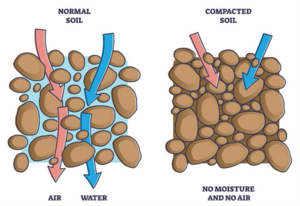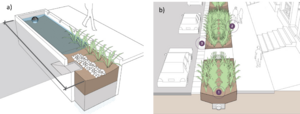
Green Stormwater Infrastructure design strategies and practices for climate resilience Revision as of 11:42, 9 April 2023 by Mtrojan (talk | contribs) (Created page with "right|100px|alt=image <div style="float:right"> <table class="infobox" style="border:3px; border-style:solid; border-color:#FF00...")
Practices to consider
|
| Many cities have ordinances against placing leaves in the street. Consider implementing a mechanism to address leaves and organic material adjacent to streets (e.g. on boulevards). Research shows that phosphorus loads in late winter and early spring are significant and it seems likely leaves and other organic material adjacent to streets contributes to this loading, though there is insufficient research to establish this relationship. Leaf collection programs or incentives to place leaves in streets just prior to sweeping may reduce this phosphorus load. |
Trends indicate Minnesota’s climate is becoming warmer and wetter. Over the last 25 years, annual average precipitation increased by 3.4 inches and temperatures warmed by 3.0°F (MN DNR, n.d.). As a result, the frequency and severity of local flooding is increasing (MPCA, n.d.)l. Summer droughts are also projected to worsen, partly due to increases in temperature (States at Risk, 2015) and longer times between rain events. These climate trends present unique challenges for managing urban stormwater systems. Green stormwater infrastructure (GSI) helps bolster a community’s climate resilience. Standard design practices for GSI can be modified or enhanced to better mitigate and adapt to climate change. These design mechanisms and practices include, but are not limited to:
- Planning GSI systems for climate change
- Enhancing infiltration and detention
- Enhancing interception and evapotranspiration
- Selecting climate resilient vegetation
- Preserving natural areas
- Enhancing harvest and reuse
- Combining grey and green practices
- Sequencing GSI in treatment trains
- Implementing real-time controls (dynamic design)
These are discussed below.
Contents
Enhancing Infiltration and Detention
Infiltration based GSI such as bioretention can reduce the impact of localized inland flooding by providing storage and infiltration of rainfall and stormwater that would otherwise overwhelm sewer and drainage systems, including small streams. Infiltration based GSI can also help mitigate the impacts of drought by enhancing groundwater recharge as well as help improve local water quality through natural processes associated with infiltration such as filtration, settling, and biological uptake of some pollutants. Enhancing the infiltration potential of GSI can be an important design criteria when designing climate resilient infiltration based GSI. The primary mechanisms to enhance infiltration include improving the soil/media of the GSI, decompacting the GSI soil, establishing deep-root vegetation, and increasing the storage volume of the GSI. These techniques can increase the rate of infiltration (i.e., how fast stormwater can infiltrate into the GSI) and improve the overall capacity for infiltration (i.e., how much stormwater can infiltrate into the GSI). Enhancing a GSI’s detention time can also help mitigate climate change impacts such as downstream localized flooding by storing more water upstream for a longer period of time and, in the case of infiltration based GSI, by providing more time for water to infiltrate. The primary mechanisms to enhance detention include increasing the GSI storage volume and increasing the residence time of the system, both of which can also enhance infiltration. The various mechanisms for enhancing infiltration and detention are explained in more detail below.
Soil/Media Improvements
Soil and media improvements can be made through amendment with organic matter which promotes a healthy soil matrix and enhances infiltration (USDA, 2008). This is particularly helpful for soils that are compacted or consist largely of clay soil. Amendments should be added to the entire GSI rather than just the planting holes. Amendments can be incorporated throughout the GSI media using tillage equipment (USDA FS, 2020). If nutrients are a local water quality concern, avoid amendments with high phosphorus or nitrogen content as these can leach from the soil to surface water causing undesirable impacts like algal growth. Note that the benefits obtained from the amendment will diminish over time as the organic matter is broken down and consumed. It is, therefore, advised to incorporate other infiltration enhancement techniques such as decompaction and diverse deep-root vegetation to create lasting infiltration benefits.
Additional Resources and Guidance:
- Soils with low infiltration capacity (MPCA): https://stormwater.pca.state.mn.us/index.php/Soils_with_low_infiltration_capacity
- Design Infiltration Rates (MPCA)
- Soil amendments to enhance phosphorus sorption (MPCA)
- Soil Amendment Guidance for Infiltration and Stormwater Treatment (CalTrans)
Soil decompaction
Soil compaction is common in urban environments and can reduce infiltration rates by as much as 70 to 99 percent (Gregory, 2006). Decompaction techniques can be used to break up dense, compacted soil. Both shallow (<18”) and deep soil decompaction (>18”) techniques exist. Deep soil decompaction will allow for roots, microbes, fungi, etc. to spread deeper into the soil which enhances the soil structure and increases infiltration. Accompanying decompaction with soil/media amendments also allows for more rapid vegetation establishment and better infiltration (USDA FS, 2020; Schwartz, 2021). Note that the effectiveness of decompaction depends on the soil moisture. Soil that is too dry is at risk of pulverization by decompaction which could create fine sediment that is likely to recompact during rain events (USDA FS, 2020), while decompaction on wet soils will not break up the soil effectively (Natural Resources Canada, 2018).
Additional Resources and Guidance:
- A guide to Soil Decompaction (Natural Resources Canada): http://www.cif-ifc.org/wp-content/uploads/2018/03/4_17-0006-Soil-Decompaction-EN_nov_29_acc-1.pdf
- The Effectiveness of Soil Decompaction for Stormwater Management (MD DOT): https://www.roads.maryland.gov/OPR_Research/MD-21-SHAUMBC2-01_Soil-Decompaction_Report.pdf
- A guide to successful subsoiling (CETAB): https://cetab.bio/system/files/publications/weill_2015._guide_to_successful_subsoiling._cetab.pdf
- Alleviating Compaction from Construction Activities (MPCA): https://stormwater.pca.state.mn.us/index.php/Alleviating_compaction_from_construction_activities
Increase Deep-Rooted Vegetation
Deep-rooted vegetation in GSI is a key component to enhancing infiltration and detention in GSI. Infiltration can be enhanced by the active roots creating macropores through which water can infiltrate and by dead roots providing organic matter to the soil and improving the integrity of the soil matrix. Additionally, leafy vegetation can shelter the soil beneath it by dissipating some of the energy of rain drops before they reach the soil surface and preventing crust formation (i.e., the formation of a compacted, poorly infiltrative layer at the top of the soil surface) on bare soil (Alizadehtazi et al., 2019). Vegetation can also enhance the detention capacity by removing water from the GSI through uptake and evapotranspiration, thereby emptying the GSI and regenerating the storage volume between rain events. Incorporating vegetation with high evapotranspiration rates into the GSI increases the removal rate and detention of runoff (GSA, 2011). In the case of retention practices, which are functionally similar to detention practices with the exception that the water is stored permanently, performance is driven more strongly by evapotranspiration rather than the GSI’s overall storage capacity, further emphasizing the importance of incorporating vegetation with high evapotranspiration rates into the GSI design (Johannessen et al., 2018). See the “Selecting Climate Resilient Vegetation” section below for more vegetation guidance.
GSI Storage Volume Sizing
Both infiltration and detention can be enhanced by increasing the storage capacity of the GSI. Increasing the storage capacity (i.e., making the GSI bigger) allows for more water to enter and be stored in the GSI, and depending on the surface area of the GSI, can also promote more diffuse infiltration into the surrounding soil. Historical and future projections of rainfall data can help determine how much bigger to make GSI. For example, if GSI are designed to retain the 90th percentile of rainfall, future rainfall projections may show that the 90th percentile of rain may be more in the future compared to twenty years ago. For GSI with limited area, as is common in urban landscapes, vertical walls provide greater surface storage capacity than graded edges.
Subsurface storage can be increased by increasing the dimensions (depth, width, length) of the GSI or by selecting media with higher void space. In areas with poor infiltrating native soils, underdrains are often required. While underdrains themselves do not add additional storage to GSI, they can be used to convey water from the GSI to the storm sewer system, reducing the risk of GSI flooding and allowing for more rapid draining of the GSI.
Additional Resources and Guidance:
- Bioretention Cell Sizing (NACTO): https://nacto.org/publication/urban-street-stormwater-guide/stormwater-elements/bioretention-design-considerations/bioretention-cell-sizing/
- Infiltration design guideline – underdrains (MPCA): https://stormwater.pca.state.mn.us/index.php?title=Infiltration_design_guideline_-_underdrains
Increasing Residence Time
Increasing the hydraulic residence time slows the rate of export of stormwater from the GSI and increases the detention time of water in the GSI. Residence time can be increased by lengthening the flow path between where water enters and leaves the GSI; by reducing the slope along the flow path; and, if using an underdrain, by reducing the size of the underdrain orifice. In tightly packed urban areas where there is not room to lengthen the flow path or expand the area of the GSI, increasing the GSI depth can be a meaningful way of increasing both the storage capacity and increasing the residence time. Residence time can also be increased by incorporating media with mixed particle size distribution that are packed more tightly, which will slow the rate of transport through the soil; however, this will also lower the infiltration rate, which may be undesirable depending on the design criteria for the GSI (GSA, 2011).
Enhancing Interception and Evapotranspiration
Enhancing interception and evapotranspiration through targeted plant and tree selection can allow more stormwater to be treated by the GSI by intercepting rainwater before it reaches the GSI or by uptake of the water in the GSI by the vegetation, thereby draining the GSI faster than through infiltration or underdrains alone.
Plants and trees with larger leaf surface areas provide greater opportunity for interception. Further, trees with more rigid and rough surfaced leaves have greater interception potential compared to flexible and smooth-surfaced leaves (Xiao and McPherson, 2016). This applies to bark as well: stemflow, or rainfall reaching the ground by conveyance down tree bark, decreases with increasing bark roughness (Barbier et al., 2009). This results in lower throughfall rates for rough-barked trees compared to smooth-barked trees (Beidokhti & Moore, 2021). Table 1 below shows interception rates for numerous mature coniferous and deciduous tree species. Interception by trees can also be estimated using models (Gómez et al., 2001 and Xiao et al., 2000)


